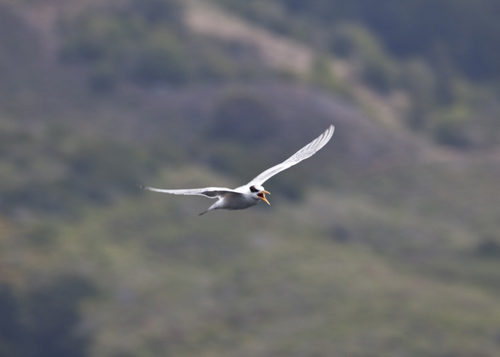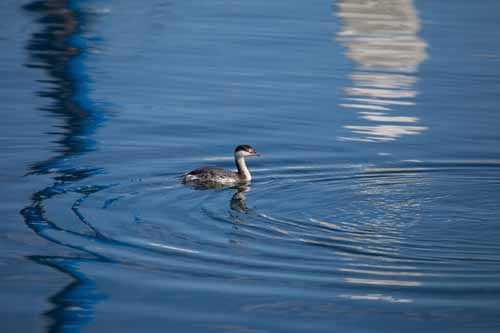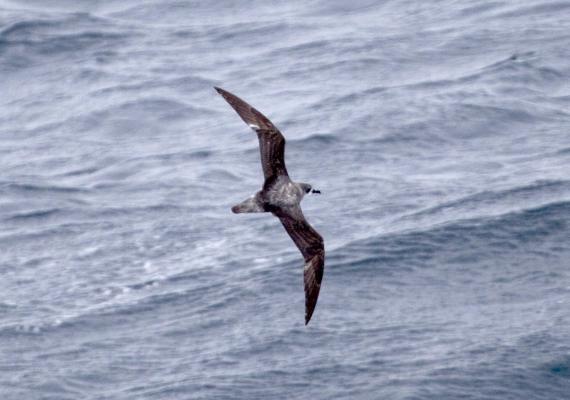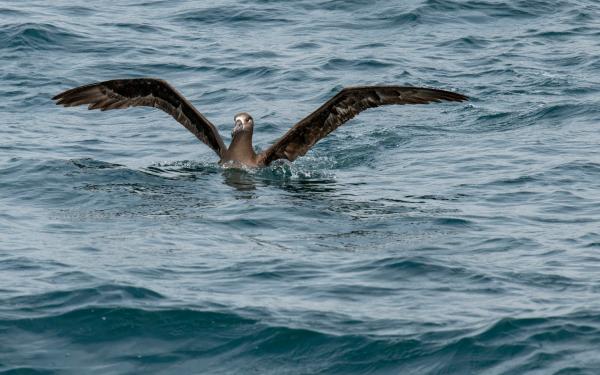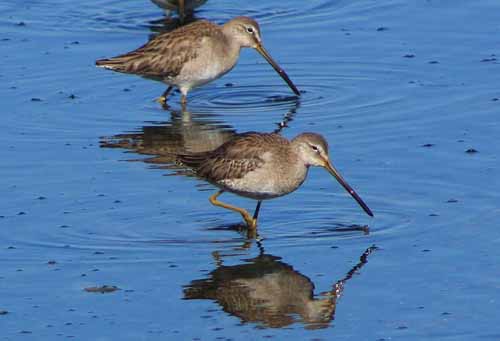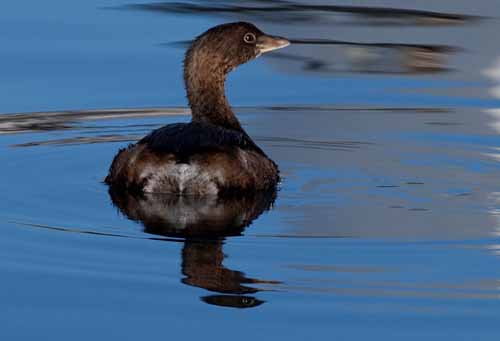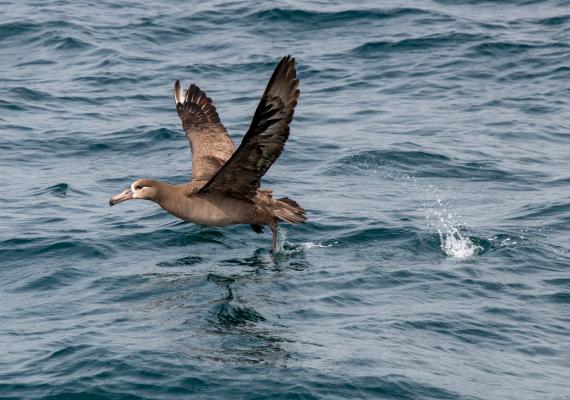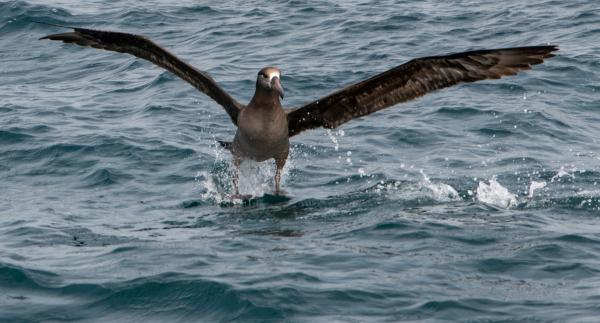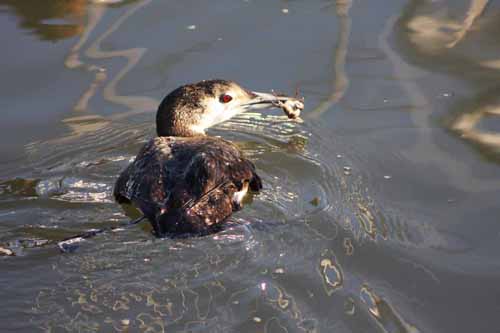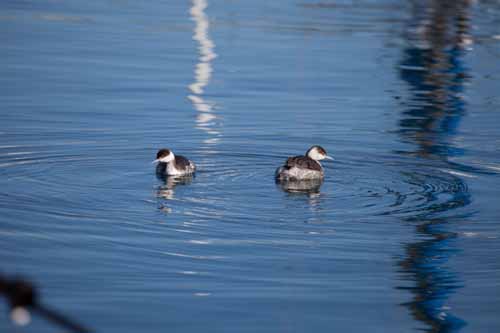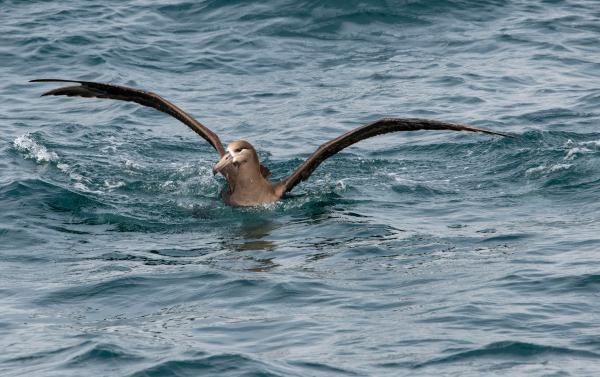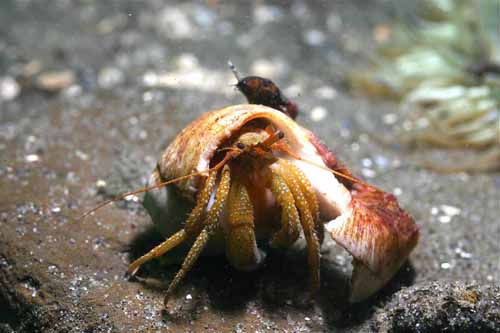Overview
The waters of the Monterey Bay National Marine Sanctuary are heavily used by seabirds and shorebirds, for many reasons:
- Upwelling that originates off Davenport and Point Sur provides feeding grounds that are rich in small fishes such as anchovies and sardines.
- The land surrounding these waters serves as nesting habitat for many species.
- The sanctuary is a convenient stop-off point for many migrating birds that come from as far away as Chile, New Zealand, Hawaii and Alaska.
Ninety-four seabird species are known to occur regularly within and in the vicinity of the sanctuary; among these, about 30 are dominant. In addition, approximately 90 tidal and wetland species occur on the shores, marshes and estuaries bordering on the sanctuary, about 30 of which are dominant. Species composition overlaps little between the tidal/wetlands and ocean habitats, except for some species of grebes, loons and ducks.
Water depth and distance to the shelf-break front are the most critical factors determining habitat use by seabirds:
- Very deep water lies within a few kilometers of shore near Moss Landing and Davenport, as a result of the presence of the Monterey and Ascension Submarine Canyons, respectively. These deep waters are populated with “pelagic” birds, such as Black-Footed Albatross, Ashy Storm-Petrel and Xantus’ Murrelet, during summer and fall – and with Northern Fulmars and Black-Legged Kittiwakes during winter and spring.
- The coastal avifauna, found over the continental shelf, is composed largely of Sooty Shearwaters, Western Grebes, Pacific Loons, Brown Pelicans, cormorants, Western Gulls and Common Murres.
- Very close to shore, usually near the breakers, are Surf and White-Winged Scoters and Marbled Murrelets.
The vast majority of seabird species in the sanctuary are seasonal visitors. Most species are seasonally resident and come in large numbers from temperate areas of New Zealand and Chile as well as Hawaii, Mexico and Alaska to winter in sanctuary waters. They exploit the rich prey resources of the area, which is located in the central upwelling region of the California Current system. The prevalence of marine birds using sanctuary waters changes from year to year, due to fluctuations in marine conditions, especially related to El Niño.
The shoreline and coastal wetlands that border the sanctuary are also important to birds. Elkhorn Slough attracts the third largest concentration of shorebirds in California, surpassed only by the much larger Humboldt and San Francisco Bays.
The dominant shorebird species on the intertidal mudflats of Elkhorn Slough and the Salinas River mouth are sandpipers, Dunlins, Sanderlings, dowitchers, Black-Bellied Plover, Willets, American Avocets, Marbled Godwits and Long-Billed Curlews. The largest avian inhabitants of the wetlands – the egrets and herons – feed on a variety of large vertebrate and invertebrate prey. Rail species, known for their secretive nature, once used sanctuary marshes, but have declined dramatically. Grebes, coots and a host of diving ducks and dabbling ducks dominate the coastal bird assemblage that uses the shallow, tidal waters of local sloughs and estuaries.
On the outer coasts, the sandy beach avifauna is dominated by Sanderlings, Willets and Marbled Godwits. The dominant species on the rocky shoreline are the resident Black Oystercatchers and Black Turnstones. These birds are most abundant during fall and winter, and during this period they are accompanied by small numbers of Ruddy Turnstones, Surfbirds and Wandering Tattlers.
Shorebirds reach their greatest densities from October through March in Elkhorn Slough. This reflects the presence of individuals moving to and from northern breeding grounds as well as large numbers of over-wintering birds. However, many shore and marsh species occur year-round, including several that breed locally.
Sanctuary waters are important to several bird species of special concern because of their small populations:
- The Marbled Murrelet population in the sanctuary is the smallest, most disjunct and, therefore, most precarious breeding population of this species.
- The Western Snowy Plover, a threatened species, nests on beaches and is vulnerable to disturbance and trampling by humans. In addition, the red fox, an introduced predator, preys upon these small birds.
- Numbers of the endangered California Clapper Rail have severely declined, and the species may have been exterminated from marsh habitats in the sanctuary.
Human impacts to seabird populations include competition for food with commercial fisheries, entanglement in fishing gear, ingestion of marine debris, and disturbance of roosting and breeding birds by watercraft and aircraft.
In addition, environmental contamination from the historical use of pesticides still affects some species. For example, the almost total reproductive failure of the Caspian Tern colony in Elkhorn Slough in 1995 was likely due to the effects of pesticide-tainted sediments washing into the slough during torrential rains.
A number of smaller oil spills have injured and killed seabirds, including Common Murres, Marbled Murrelets and Rhinoceros Auklets, in the sanctuary. A large oil spill from tankers transiting sanctuary water is an ongoing threat to seabirds and shorebirds.
Monitoring
The variety and abundance of species found in the sanctuary provide a unique opportunity for observation. Monitoring seabirds and shorebirds can help detect critical population changes and provide essential data to determine what protection measures may be needed.
A number of ongoing multi-year studies are monitoring the distribution, abundance and movement patterns of large pelagic animals, including seabirds and marine mammals. West Coast CSCAPE, Tagging of Pacific Pelagic (TOPP), and Center for Integrated Marine Technology (CIMT) programs are three such monitoring programs. Highlights from other monitoring programs are described below.
Beach COMBERS (Coastal Ocean Mammal/Bird Education and Research Surveys)
In 1997, the sanctuary began this program using trained volunteers to survey beached marine birds and mammals monthly at selected beach sections from Waddell Creek to Morro Bay. The program’s long-term goals are to provide a baseline of the average presence of beach-cast marine organisms and to assist the sanctuary in early detection of die-offs or mortality events (which can be triggered by both natural and human-related environmental disturbances).
Data collected on the high deposition of Common Murres helped lead to the discovery of the threat gillnets pose to birds, harbor porpoises and sea otters. (For more information on Beach COMBERS, see the Beaches section.)
Tracking Black-Footed Albatross Movements and Conservation
The Black-Footed Albatross (Phoebastria nigripes) has recently been listed as endangered by the World Conservation Union (IUCN). Assessing albatross movements and habitats during the post-breeding season is a top conservation priority.
Eighteen birds were tagged in central California during the first two years of this study (2004-2005). Males and females were found to occupy different oceanic regions during the post-breeding season, with males venturing farther west than females. Overall, the tracked birds spent approximately 60 percent of their time in the high seas beyond national Exclusive Economic Zones. Of the time spend in U.S. territorial waters, 42 percent was spent within the three central California national marine sanctuaries.
The Distribution and Abundance of Marine Birds in Nearshore Waters of Monterey Bay
Monterey Bay is a site of regional significance for marine birds, particularly during winter. This study, completed by a researcher at Moss Landing Marine Laboratories, measured the seasonal abundance of nearshore (less than 1 kilometer, or 0.62 miles, from shore) marine birds and some of the factors affecting their distribution in Monterey Bay from 1999 to 2000.
Species assemblages were found to be fairly consistent between the same season in different years.
Total marine bird abundance was greatest during migration periods in spring and fall. Total marine bird diversity was greatest during winter. Mean density of all species (363 birds per square kilometer) was considerably greater than density reported for Monterey Bay as a whole, indicating that the nearshore environment should receive unique consideration in marine bird abundance and distribution studies.
Long-Term Studies of Seabirds on Año Nuevo Island and Mainland
Año Nuevo Island (ANI) is the largest and most diverse seabird breeding colony in the sanctuary, hosting breeding populations of seven species. In addition, the island is an important roosting site for Heermann’s Gulls and the endangered Brown Pelican.
Monitoring of seabirds on ANI by PRBO Conservation Science began in 1992. Rhinoceros Auklet, Brandt’s Cormorant and Western Gull populations increased from 2002 to 2003, to the highest levels yet recorded for the island. Auklet diet reveals a shift from an anchovy-based diet in the 1990s to a rockfish-based diet in recent years, corresponding to a shift in ocean climate in 1998-1999.
Photos
Maps
Projects
Beach Watch
Beach Watch is a long-term, beach-monitoring project. Beaches surveyed stretch from Bodega Head in Sonoma County down to Año Nuevo in San Mateo County. Volunteers survey a designated beach segment counting, identifying, and photo-documenting live and dead birds and marine mammals and human activity on- and immediately offshore.California Cooperative Oceanic Fisheries Investigations (CalCOFI)
The California Cooperative Oceanic Fisheries Investigations (CalCOFI) was formed in 1949 to study the ecological aspects of the Pacific sardine population collapse off California. Today, the focus has shifted to the study of the marine environment off the coast of California, the management of its living resources, and monitoring the indicators of El Nino and climate change.
Coastal Ocean Mammal and Bird Education and Research Surveys (Beach COMBERS)
In 1997, we began a beach survey program called Coastal Ocean Mammal and Bird Education and Research Surveys (Beach COMBERS) using trained volunteers to survey beached marine birds and mammals monthly at selected sections of beaches from Wadell Creek to Morro Bay.Common Murre Restoration Project
The Common Murre Restoration Project is a cooperative effort involving U.S. Fish and Wildlife Service and other organizations. The primary goal of this project is to restore the Common Murre colony at Devil's Slide Rock as well as enhancing populations of other central California murre and seabird colonies by identifying and reducing threats.CSCAPE: Collaborative Survey of Cetacean Abundance and the Pelagic Ecosystem.
CSCAPE is a collaboration between the National Marine Fisheries Service and the National Marine Sanctuary Program to assess the abundance and distribution of marine mammals and to characterize the pelagic ecosystem out to ~300 nautical miles off the U.S. West Coast.Davidson Seamount: 2010 Marine Mammal & Seabird Survey
MBNMS staff and UCSC scientists conducted a ship-based survey of the waters above and around the Davidson Seamount for three days in July 2010. Efforts aboard the NOAA Ship McArthur II represent the first dedicated at-sea surveys of Davidson Seamount for marine mammal and seabirds.Davidson Seamount: 2010 Marine Mammal Aerial Surveys
In 2010, the Monterey Bay National Marine Sanctuary (MBNMS) and its partners conducted two aerial surveys of the surface waters surrounding the Davidson Seamount, an area typically regarded as having a higher abundance and diversity of marine mammals and seabirds.Distribution and Abundance of Marine Birds in Nearshore Waters of Monterey Bay, California
Monterey Bay, California is a site of regional significance for marine birds, particularly during winter. This study measured the seasonal abundance of nearshore (<1 km from shore) marine birds and some of the factors affecting their distribution in Monterey Bay from 1999 to 2000.Long-term Studies of Seabirds on Año Nuevo Island and Mainland
Long-term monitoring of seabirds on Año Nuevo Island by PRBO Conservation Science.Marbled Murrelets: Abundance and Productivity in Central California during the 2007 and 2008 Breeding Seasons
We conducted at-sea surveys for Marbled Murrelets (Brachyramphus marmoratus) in central California between Half Moon Bay and Santa Cruz in 2008 and down to Moss Landing in 2007. We estimated the central California population to be 174 (95% CL: 91-256) using all surveys data (n = 6). These estimates represent 54-55% declines since 2007 and 71-80% declines since 2003. These results and the lack of juveniles indicate that Marbled Murrelets in central California will almost certainly become locally extirpated when the current cohort of adults dies.Seabird Protection Network
The Seabird Protection Network addresses human disturbance to breeding seabird colonies along the central California coast. These efforts are accomplished through a collaborative, multi-agency outreach program combined with monitoring, law enforcement and management actions.Tagging of Pacific Predators (TOPP)
The Tagging of Pacific Pelagics (TOPP) research program aims to understand the migration patterns of large predators in the North Pacific basin and how these animals act and interact in their open ocean habitats. By using satellite tagging techniques, TOPP researchers follow the movements of different species across multiple trophic levels (i.e., the food web) and in relation to physical oceanographic features in order to piece together a whole ecosystem picture.Tracking Black-footed Albatross movements and conservation
Oikonos Ecosystem Knowledge, working with government and university partners has collected data on the oceanic distribution of post-breeding and chick provisioning Black-footed Albatross (Phoebastria nigripes) tagged at two locations (Cordell Bank and Kure Atoll) over four years (2004, 2005, 2007, 2008). Their distribution is described in the context of static oceanic habitats (bathymetric domains and features) and management jurisdictions.Tracking Sooty Shearwater habitat use throughout dynamic upwelling ecosystems in the California Current
Scientists tracked Sooty Shearwaters (Puffinus griseus) within the California Current ecosystem during their summertime feeding period and used the data to locate aggregations of prey species such as anchovy, sardine, krill and squid.Links
A Year on the Wing
Information, activities and resources about birds and the ecology and culture of the places they visit. Includes free shorebird & flyway poster, education kits and much more. Choose documentary in flash or HTML format. Focused on the migratory wading birds of the East Asian-Australasian Flyway.http://www.abc.net.au/wing/ayowflash.htm
Birds of Elkhorn Slough
Resources for birdwatchers at Elkhorn Slough include a checklist, bird sightings log, and more information.http://www.elkhornslough.org/sloughlife/birds/
eBird
eBird, a project developed by the Cornell Lab of Ornithology and the National Audubon Society, provides a simple way for you to keep track of the birds you see anywhere in North America. You can retrieve information on your bird observations at any time for your personal use. You can also access the entire historical database to find out what other eBirders are reporting from across North America. In addition, the cumulative eBird database can be used to learn more about the distributions and movement patterns of birds across the continent.http://www.ebird.org/content/
eBird
eBird, a project developed by the Cornell Lab of Ornithology and the National Audubon Society, provides a simple way for you to keep track of the birds you see anywhere in North America. You can retrieve information on your bird observations at any time for your personal use. You can also access the entire historical database to find out what other eBirders are reporting from across North America. In addition, the cumulative eBird database can be used to learn more about the distributions and movement patterns of birds across the continent.http://www.ebird.org/content/
Elkhorn Slough National Estuarine Research Reserve – Caspian Tern Story
A case study of the trials and tribulations of Caspian Tern nesting colonies at Elkhorn Slough. Also check related information on their general website.http://www.elkhornslough.org/caspiantern/caspiantern.htm
International Brant Monitoring Project
The International Brant Monitoring Project was developed to monitor the migration of a small sea goose, the brant, along the Pacific Flyway. Participants gain a greater understanding of the importance of local ecosystems and global environmental health through the observation of brant and sharing of information. Students monitor through field observations and by counting brant in their area and then share their findings with others via the Internet.http://www.padillabay.gov/brant/
Monterey Bay Aquarium - Online Activity, "Bird Bingo"
The ocean and its coastline are home to hundreds of different types of birds, each with its own size, shape, and color. Bird bingo is a fun way for students to learn more about birds.http://www.mbayaq.org/lc/activities/bird_bingo.asp
Monterey Bay Aquarium - Student and Teacher Resources and Activities
The Monterey Bay Aquarium offers teacher and student resources including: species and habitat-specific information, live cams, classroom activities, and interactive online games.http://www.mbayaq.org/lc/
Monterey Bay National Marine Sanctuary - Seabirds and Shorebirds
A comprehensive and educational scientific characterization of birds in the Monterey Bay Sanctuary.http://montereybay.noaa.gov/sitechar/bird.html
Monterey Bay National Marine Sanctuary - Slideshow
Slideshow that includes photos of landscapes, marine mammals, birds and other organisms found in the Monterey Bay.http://montereybay.noaa.gov/visitor/slideshow/slideshow.html
Monterey Bay Pelagic Bird Images
See photos of pelagic birds taken in the Monterey Bay.http://www.montereybay.com/creagrus/MtyBaybirds.html
OBIS-SEAMAP: Ocean Biological Information System - Spatial Ecological Analysis of Megavertebrate Populations
A digital database of marine mammal, seabird, and sea turtle distribution and abundance. The web-based system will allow the interactive display, query, and analysis of the digital archive in conjunction with environmental data.http://seamap.env.duke.edu/
Pacific Seabird Group - Seabird Gallery
Images of Pacific Seabirds for use in public presentations and education.http://www.pacificseabirdgroup.org
PBRO: Point Reyes Bird Observatory - Conservation Science
PRBO Conservation Science's staff and seasonal scientists apply bird ecology studies to conserve birds, other wildlife and ecosystems in western North America, the north Pacific Ocean and beyond.http://www.prbo.org/cms/index.php
Point Reyes Bird Observatory - Conservation Education
Bird education resources, including: K-12 programs, bird and wildlife information, activities for kids, and information on birding in Pt. Reyes.http://www.prbo.org/cms/index.php?mid=40&module=browse
Satellie Tracking of the Sooty Shearwater
Maps of the Trans-Pacific migration of the Sooty Shearwater from satellite tracking. User must first accept the terms of use for the website.http://www.seaturtle.org/tracking/?project_id=46
Seabird Protection Network
Nearly 8 million people live in the San Francisco Bay Area. This fact, combined with the largest concentration of breeding seabirds in the contiguous U.S., give rise to many opportunities for wildlife disturbance. The Seabird Protection Network uses a 3-pronged approach: 1) Outreach & Education, 2) Enforcement & Coordinated Management, and 3) Monitoring, to informs coastal and ocean users about seabirds. The goal of the Network is to minimize human-related disturbances to breeding and roosting seabird colonies, along the central California coast. Open in new window:http://farallones.noaa.gov/eco/seabird/welcome.html
The Bridge - Ocean Sciences Teacher Resource Center
Materials and curricula related to many areas of study in the Monterey Bay. Be sure to check the data tip of the month archives. (Supported by the National Sea Grant Office, the National Oceanographic Partnership Program, and the National Marine Educators Association.)http://www.vims.edu/bridge/
U.S. Fish and Wildlife Service - Shorebird Sister Schools Program
Linking schools, biologists and shorebird enthusiasts along flyways, students from all over the western hemisphere track arctic-nesting shorebirds along their migration routes and share their class field experiences with other students. Students also have the opportunity to ask biologists questions, follow research projects and help scientists gather data. This site includes many on-line activities and curriculum for students and teachers.http://sssp.fws.gov/index.cfm
USGS - Surf Scoter Study
The San Francisco Bay Estuary Field Station of the U. S. Geological Survey, Western Ecological Research Center has been leading studies on the ecology of wintering waterbird populations and their contaminant risks, including cross-seasonal studies linking them to migration and breeding areas.http://www.werc.usgs.gov/project.aspx?projectid=179
